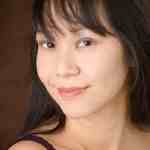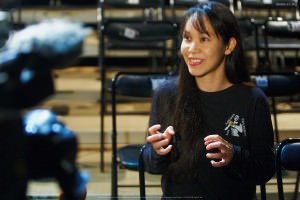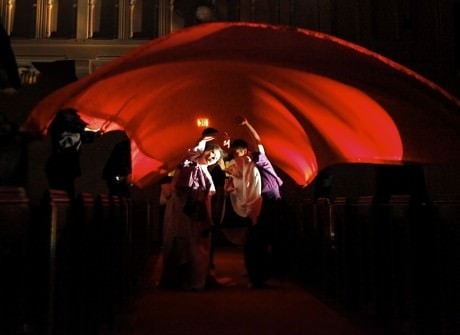Welcome back to the conversation and The Playwright’s Playground, an in-depth conversation with female playwrights in the D.C. theatre community. Female theatre artists make up more than 50 percent of those involved in the theatre, yet the number of female playwrights being produced is dramatically lower. In this continuing Interview Series, I will introduce DCMTA readers to the many talented playwrights in the DMV area to learn about their writing process, their inspirations, and the motivations and struggles to write and produce their art.

Izumi Ashizawa. She’s bold. She’s impressionistic, and she demanding of your attention. The artistic stylings, reputation, and international acclaim of Izumi Ashizawa is that of a woman of many talents and of one who wears many hats. Izumi is a director, a performance artist, a costume designer, a puppeteer, a dramaturg, a choreographer, and she is a playwright. This 2010 winner of the Kennedy Center’s American College Theater Festival Faculty Achievement Award (Dreams in the Arms of the Binding Lady) and recipient of a Capital Fringe Director’s Award is also an Assistant Professor of Directing and Devised Theatre at State University of New York-Stony Brook and holds Masters degrees in English Literature from the University of the Sacred Heart of Japan and Dramaturgy from the Yale school of Drama.
It is my delight to share with you an enlightening and ‘spirited’ conversation with the Japanese born and raised Ashizawa who is the Co-Writer and Director of Spooky Action Theatre’s interactive production of Kwaidan currently playing at The Universalist National Memorial Church until June 22nd
Part I:Izumi Ashizawa & The Art of Kwaidan: The Origins and Building of a Production.
Izumi guides us through the interdisciplinary collaborative process of physical storytelling and the adaptation of Kwaidan.
Part II: Izumi Ashizawa – The Inspirations and Passions of a Japanese Interdisciplinary Artist. The instinctive insights of Izumi are explored as she discusses playwriting and the origins of her visual style, the motivations of her work ethic and the personal impact of a life dedicated to art.
______
Sydney-Chanele: You are a woman of many talents, and if I search your name I will find that you hold many ‘titles’ – playwright, director, performance artist, costume designer, puppeteer, and professor. Yet, you defy being labeled. How do you describe or see yourself as an artist?

Izumi: I have to say, I am still searching. Artists are always searching, and part of the fear is to repeat the same thing again and again. I always like challenges, new perspectives, and going onto different paths. With productions I have similar and core approaches that I definitely use, however I try to push myself and then try different approaches to directing.
Subtle, sensual beauty is how your interactive, visual work is often described. What adjectives would you use to describe your work, your artistry?
Good question. Grotesque. Beautiful. Sublime. Pathos.
Visual emotion. What attracts you to such opposite descriptions?
From the very beginning, even when I was three years old I was attracted to the complete opposite. The juxtaposition makes it more interesting than simple beauty.
What happened when you were three that makes you say that?
It’s really a strange thing to say but I was really intrigued by my mother’s pearl necklace, and the fragile nature that if I cut it then it will fall. I actually took the scissors-but what I liked was the moment of when I was just about to cut it. That kind of tension – I really loved it. Of course I didn’t understand the concept, but I felt it. I finally cut it and then I cried.
Why do you think you cried? Were you shocked or were you afraid of the repercussions?
No, No, I initiated it. This was the internal journey I went through, yet, somehow I also felt it was beautiful – the action of the falling pearls. Again, a complete opposite, the fragility of the matter was quite intriguing. I was really aware of how it was connected and aware of the fragility and how it can go away in one second.
I think that is related to the concept of Japanese beauty – just like Cherry Blossoms. One of the reasons we like them is because they last such a short period of time. Cherry Blossoms bloom extremely beautifully, but it only lasts three to five days. But, because of that, they look more beautiful. When the Cherry Blossoms fall, that’s also beautiful. When they do, I cry too.
I think that was a great analogy, and I see your view of the beauty in that. Your story is an excellent example in describing the visual style of your work – tension and release.
Thank you and I think all the movements that I do are tension and release. Tense movement and then stop. Silence. I think that juxtaposition and that philosophy always exists in the movement (in Kwaidan) and the entire performance.
You are known for your interdisciplinary approach to the theatre arts – performance art, devised theatre, and now the stylized, interactive theatre of Kwaidan. How do you define theatre?
That’s a really good and big question. I think the question first is why do we still do theatre in this century. I question myself, always. So I think that’s one of the definitions of theatre – why do we still do it. One of the answers is, theatre is a live creature. It changes. Sometimes you can’t control it. It has all these ups and downs, and then the moment comes when all is right, and it’s just magical. It’s almost like childbirth. I don’t have any children, but I think I understand the pain and the emotional process. When you have the baby and are holding it in front of you, you say that wasn’t so bad, one more.
That’s how it is with theatre, that repetition and cycle of life. The beauty is that it won’t stay. When the show is over, it’s over. Theatre is great that way.
Shifting gears here, how did your experiences at the Yale School of Drama influence your playwriting and creation of your own performance work?
That was the beginning. And, the first time I created a new performance was in a cabaret at Yale Drama. It was really experimental. That style and that environment allowed me to explore risk and then I became addicted to it. However, I also think there is a relationship between the Japanese way of making theatre. In Japan, playwrights and directors are usually the same person. That’s really common in Japan. Here it’s not so common. Noh Theatre from the very beginning, playwrights are the performers and the directors too. So, we are really used to that idea.
You have written and performed your works all around the globe. How does the status of the Playwright differ around the world?
American playwrights have more control in terms of the production. Playwrights have more authority here with their written word. If you don’t want to change something – it can’t be done without permission. Whereas in Europe and many other places – but Europe especially – people can do whatever. It’s up to the production. You can cut and paste and shift the order. If the playwright doesn’t like it but the director wants it, they just make the changes they want.
It’s always interesting to hear European director and American directors talk about it because it’s always a heated argument.
I am particularly interested on your take on the role of female playwrights in the United States.
I think America is really in a better situation. In Japan there are not that many female playwrights accepted – or directors. That’s one of the reasons why I wanted to go abroad and come to the United States. If you want to do something different and explore, I felt that I could not do what I wanted to do – It’s a really male-oriented world. The female playwright’s here have much better conditions and acknowledgment than in Japan.
Is being an artist an easy life choice for your family to accept?
No, I don’t think so because I am their only child. They didn’t like the idea at first. They wanted me to be like my friends – traditional ways because it’s not worrisome. But now they accept it. It was a gradual thing. It evolved. I was a really strange child, so they say I’m still doing the same thing. They accept the way I am and I really appreciate that.
I’m going back home to Japan to visit for about two weeks, and then I will come back to restage the accessible performance at Atlas.

What are the details of the adjustments you’ll make for that accessible performance of Kwaidan on June 17th at Atlas?
It’s just one day but it’s a completely different space. We want to maintain the spirit of the guided tour. It’s a journey. So we are going to create a maze in the space there with dividers, and create the sense that the audience is traveling through one story to another. It’s a challenge because we’ll be still running the production during this time. We have Sunday performances at the church, and then we move there for the Tuesday performance, then we are back at the church again.
What drives you to continue to work, and work, and work like you do?
I think I like it. I like traveling and the nomad’s situation. In the end any performance/production is not about one person. It’s team work. The magic happens when different people’s perspective meet and something much better and bigger happens. That’s the moment I really like.
What are your upcoming projects?
It will be a co-production and a commission of sorts, and it’s something I’m currently still writing. Mysterious Lake will take place in New York and DC in 2015 and it’s a play for children with lots of puppets and movement. It’s inspired by Kwaidan and also a former work I directed in Bulgaria. In May 2015, I will be working with The Royal Academy of Dramatic Arts in London. That also is not written yet, but I will train actors and build something with them. It will be a devised theatre piece.
Do your passion and dedication to your art ever interfere with you having a solid personal life, a private life?
Sometimes. Yes. But I think the work is more and more a priority than anything else. Japanese professionalism is part of what I grew up with; the work always comes first. It’s hard but to become a director I think you have to know how everything works, backstage and otherwise. That’s the Japanese discipline system.
I was told by my former boss in Japan that if you are in the theatre world, and you parents are on their death bed that you will not see your parent’s death. It’s a choice and if you don’t like it then you shouldn’t be in this world. From the very beginning I was told that, so the professionalism is extremely serious. That is something that is always in my mind, and because of that it’s not a big deal to work the way I do. I love theatre!
______
As part of the Kwaidan run, SAT will be offering a FREE screening of Kwaidan (donation suggested), the 1964 movie also based on Lafcadio Hearn stories, and a talk-back with Michael Dirda, a Fulbright Fellowship recipient and a Pulitzer Prize–winning book critic for the Washington Post.
Directed by Masaki Kobayashi, Kwaidan the movie consists of four separate and unrelated stories: The Black Hair, The Woman of the Snow, Hoichi the Earless and In a Cup of Tea. The screening will be hosted by Michael Jeck, adjunct professor of film history at George Mason University and note writer for Film Forum Rep, NY, since 1991.
Author of the article The Ghost Stories of Lafcadio Hearn, Michael Dirda will moderate a talk-back between the Kwaidan ensemble and the audience.
Kwaidan (1964)
Directed by Masaki Kobayashi
Hosted by Michael Jeck
June 14, 2014 Sat @ 3:00 PM
Talk-back with Michael Dirda
June 15, 2014 Sun @ 4:30 PM
Kwaidan plays through June 22, 2014 at Spooky Action Theater performing at The Universalist National Memorial Church-1810 16th Street, NW, in Washington, DC. For tickets, call (202) 248-0301, or purchase them online.
LINKS
Part I: Izumi Ashizawa & The Art of Kwaidan: The Origins and Building of a Production.
Meet the Cast of Spooky Action Theater’s ‘Kwaidan’: Part 1: David Gaines and Tuyet Thi Pham.
Izumi Ashizawa’s Website.
Other interviews in The Playwright’s Playground.
My review of Kwaidan on DCMetroTheaterArts.





